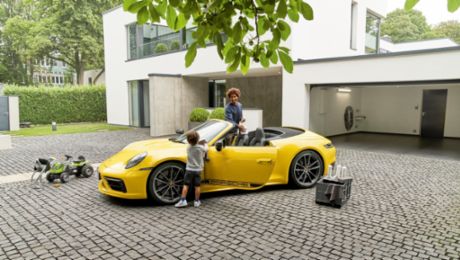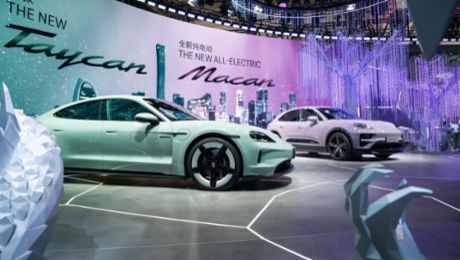Faster, higher, further – Porsche has given the Taycan a particularly extensive update. The electric sports car excels over its predecessor in every discipline: The new models have more power, longer range, accelerate faster and charge in less time with greater stability. Porsche has also sharpened the design and more strongly differentiated the Turbo models. All Taycan versions feature an even more extensive standard equipment list and come with the latest generation of the Porsche Driver Experience. The Porsche Driver Experience stands for a fully digital display, versatile individualisation and intuitive operation.
The extensive modifications will feature from the date of launch in all three body variants – the Taycan sports sedan Taycan Sports Sedan Models (2024): Electric power consumption* combined (WLTP) 20.9 – 16.7 kWh/100 km, CO₂ emissions* combined (WLTP) 0 g/km, CO2 class A , the versatile Taycan Cross Turismo Taycan Cross Turismo Models (2024): Electric power consumption* combined (WLTP) 22.0 – 18.7 kWh/100 km, CO₂ emissions* combined (WLTP) 0 g/km, CO2 class A , which is available with an off-road design package, and the sporting-yet-practical Taycan Sport Turismo Taycan Sport Turismo Models (2024): Electric power consumption* combined (WLTP) 21.8 – 17.6 kWh/100 km, CO₂ emissions* combined (WLTP) 0 g/km, CO2 class A . In each case, four powertrain options are available, with rear- and all-wheel drive variants. The revised versions are slated to arrive at Porsche Centres from the spring of 2024.
On the path to series production, development engineers and test drivers covered over 3.6 million kilometres around the world in camouflaged test cars to keep improving the first all-electric sports car from Porsche. The sports car manufacturer has produced almost 150,000 units of the Taycan to date. The most important individual markets for the Taycan are currently the US, the UK, Germany and China.
“We ushered in the new era of e-mobility with the Taycan at the end of 2019. It immediately proved to be a game changer and innovative pioneer in the e-vehicle segment,” says head of the model line, Kevin Giek. “We are now continuing this success story with the extensively updated Taycan. The model line has reached new heights in terms of performance, with exceptional driving dynamics and driving pleasure. At the same time, we were able to significantly improve efficiency, range, day-to-day usability and comfort.”
Facts and figures: the main improvements
All models boast even better acceleration. The Taycan Turbo S sports sedan Taycan Turbo S (2024): Electric power consumption* combined (WLTP) 20.5 – 17.9 kWh/100 km, CO₂ emissions* combined (WLTP) 0 g/km, CO2 class A , for example, needs a mere 2.4 seconds for the sprint from 0 to 100 km/h, making it 0.4 seconds faster than its direct predecessor. The base sports sedan accelerates to 100 km/h in 4.8 seconds – 0.6 seconds quicker than its predecessor.
The Taycan sports sedan with rear-wheel drive and Performance Battery Plus is the pinnacle: with a single battery charge, it can travel up to 678 km (WLTP), which is 175 km more than before.
The Taycan charges at up to 320 kW at high-power DC chargers with 800-volt technology. That’s 50 kW more than before. This reduces the charging time from ten to 80 per cent SoC to less than 18 minutes – and not just when the conditions are ideal. This is because the fast-charging window of the new performance battery has been significantly extended. This means that charging capacities of more than 300 kW can be sustained for up to five minutes, and very high charging capacities can be achieved more quickly, even at low temperatures. Depending on the individual driving profile, this can cut the time required to go from a ten to an 80 per cent charge by half compared to the predecessor. In the first-generation Taycan, the charging time from 10 to 80 per cent SoC at 15 degrees Celsius is 37 minutes. Under the same conditions, the upgraded Taycan takes just 18 minutes despite its larger battery capacity.
The new electric motor on the rear axle of the Taycan generates 80 kW more power than the predecessor and yet is 10.4 kg lighter.
The Performance Battery Plus now has a gross energy content of 105 kWh, increased from 93 kWh.
The maximum recuperation capacity during deceleration from high speeds has increased from 290 to up to 400 kW.
The high-performance high-beams of the optional HD matrix LED headlights offer innovative functions such as lane brightening, construction-site and bottleneck light and adaptive motorway high-beam lights. There are over 32,000 individually controllable micro-LEDs in each headlight. The adaptive motorway high beam can also illuminate the road to a distance of over 600 metres. The main headlights generate a bright, homogeneous and precise carpet of light that adapts dynamically at lightning speed to the respective driving situation. The new adaptation is calculated every 16 milliseconds.
With the new push-to-pass function[1] in the Sport Chrono package, a boost of up to 70 kW, depending on the model, can be called upon for 10 seconds at the touch of a button.
With the new 3D driver assistance display, Taycan drivers can now choose from six views on the instrument cluster.
The Porsche Charging Planner has been improved. Route planning is now online and is up to three times faster.
The Porsche Charging Service enables access to charging points from a range of providers all over the world. Currently, almost 600,000 charging points are connected in Europe in 24 countries.
[1] Possible in combination with the Performance Battery Plus. Not available for 2WD models of the Taycan and Taycan Sport Turismo or the Taycan 4 Cross Turismo.


